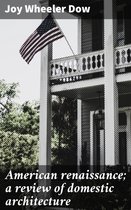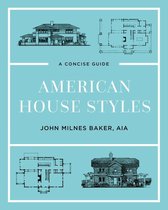American Renaissance: A Review of Domestic Architecture Ebook Tooltip Ebooks kunnen worden gelezen op uw computer en op daarvoor geschikte e-readers.
Afbeeldingen
Sla de afbeeldingen overArtikel vergelijken
- Engels
- E-book
- 9781465629432
- 24 februari 2021
- Adobe ePub
Samenvatting
The magnificence of this subject, even of a single branch—the domestic phase—is disproportionate to a review in one volume, in the scope of which, I fear, I cannot achieve much more than a respectable introduction. But even an introduction, like the overture to an opera, is better begun at the beginning. Civilized man, and especially one of Anglo-Saxon descent, is a home-loving creature. To him the dwelling-place stands for his most important institution. The arts, sciences and traditions he pursues, mainly as they are to minister unto it, and its fruition is the goal of life. About this dwelling-place, then, there must be a very great deal to be said, indissolubly associated as it is with everything in life worth having—one’s childhood, parents, children, wife, sweetheart, and next to these one’s own personal comfort—one’s hours of leisure and recreation. Therefore, just so much as domestic architecture departs in an impersonal, artificial way from whatever relates to or reflects these associations, just so much does it err—does it fail. It will be obvious, upon a moment’s consideration, that any cold-blooded practice or discussion of academic formulæ, alone, looking to the development of American domestic architecture, is hopelessly inefficient. The home one builds must mean something besides artistic and engineering skill. It must presuppose, by subtle architectonic expression, both in itself and in its surroundings, that its owner possessed, once upon a time, two good parents, four grandparents, eight great-grandparents, and so on; had, likely, brothers and sisters, uncles and aunts, all eminently respectable and endeared to him; that bienséance and family order have flourished in his line from time immemorial—there were no black sheep to make him ashamed—and that he has inherited heirlooms, plate, portraits, miniatures, pictures, rare volumes, diaries, letters and state archives to link him up properly in historical succession and progression. We are covetous of our niche in history. We want to belong somewhere and to something, not to be entirely cut off by ourselves as stray atoms in boundless space either geographical or chronological. The human mind is a dependent thing and so is happiness. We may not, indeed, have inherited the house we live in; the chances are we have not. We may not remember that either of our parents or any of our grandparents before us, ever gloried in the quiet possession of as ideal a homestead as is illustrated in Plate I to convey the atmosphere intended; but for the sake of goodness—for the sake of making the world appear a more decent place to live in—let us pretend that they did, and that it is now ours. Let us pretend that God has been so good to us, and that we have proved worthy of His trust. With this amount of psychological preparation, I believe it is possible for every cultivated American man or woman to approach the subject of American Renaissance architecture—domestic architecture—in the true spirit of understanding. By American Renaissance I allude to no “American eclectic style.” That term “eclectic style,” which so frequently crops out in treatises upon architecture, were you to follow it up, would be found to signify, as a rule, merely American nonsense and aberration. And I suppose there is no nation which may show such an imposing array of architectural nonsense as the United States during the last fifty years of their independence. Certainly no nation has evolved a national style of architecture, intentionally, as is constantly urged upon American enterprise. Such a thing could have no historic value, while it could not escape being vulgar and monotonous.
Productspecificaties
Inhoud
- Taal
- en
- Bindwijze
- E-book
- Oorspronkelijke releasedatum
- 24 februari 2021
- Ebook Formaat
- Adobe ePub
Betrokkenen
- Hoofdauteur
- Joy Wheeler Dow
- Hoofduitgeverij
- Library Of Alexandria
Lees mogelijkheden
- Lees dit ebook op
- Android (smartphone en tablet) | Kobo e-reader | Desktop (Mac en Windows) | iOS (smartphone en tablet) | Windows (smartphone en tablet)
Overige kenmerken
- Studieboek
- Nee
EAN
- EAN
- 9781465629432
Je vindt dit artikel in
- Categorieën
- Taal
- Engels
- Boek, ebook of luisterboek?
- Ebook
- Beschikbaar in Kobo Plus
- Beschikbaar in Kobo Plus
- Beschikbaarheid
- Leverbaar
Kies gewenste uitvoering
Prijsinformatie en bestellen
De prijs van dit product is 4 euro en 99 cent.- E-book is direct beschikbaar na aankoop
- E-books lezen is voordelig
- Dag en nacht klantenservice
- Veilig betalen
Rapporteer dit artikel
Je wilt melding doen van illegale inhoud over dit artikel:
- Ik wil melding doen als klant
- Ik wil melding doen als autoriteit of trusted flagger
- Ik wil melding doen als partner
- Ik wil melding doen als merkhouder
Geen klant, autoriteit, trusted flagger, merkhouder of partner? Gebruik dan onderstaande link om melding te doen.








